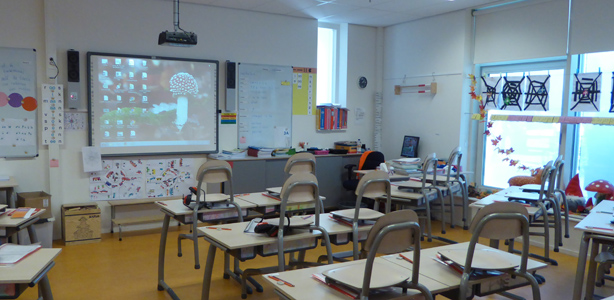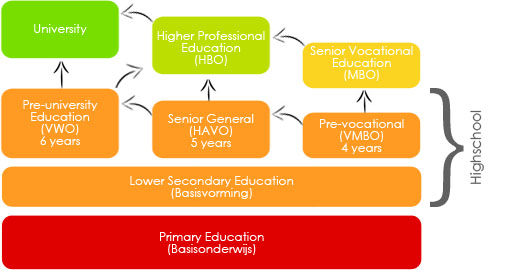The Dutch school system is quite a special school system that is not seen in many countries. Therefore most expats will not be familiar with it. It already starts at primary school, and it continues all the way up until the start of university (after that it’s the same!). Have you been wondering about the Dutch school system before because the stories of your Dutch friends sometimes confuse you, or do you maybe have kids of your own that need to enter the Dutch school system sooner or later? Then keep reading. On second thought, keep reading regardless.
Primary school is free in The Netherlands. School becomes mandatory from the age of five, by law. However, most children start going to primary school when they are four. At that point they usually go to school for only a day or two each week, to get used to having to go to school. Whether they’re four or five, they start in ‘groep 1’, which means group 1. Then, depending on observation systems that are in place in the school as well as tests, it will be assessed whether the next school year (starts in August / September) they start in the next group, ‘groep 2’, or stay another year in ‘groep 1’. This procedure is repeated each year (each ‘groep’). It is also possible that schools decide to let a pupil skip a groep, and go from groep 1 to groep 3, for example.
In total there are eight years of primary school, and the eighth year, groep 8, is quite important. It is in this year that the pupils in most schools in The Netherlands (there are exceptions) take their final Cito-toets. There will have been more of them they had to take throughout primary school, but this final one carries more weight, in practice. This Cito-toets gives as a result a final score, ranging from 500 to 550. That score is paired with an advice on the type of secondary education (= high school) the pupils should follow, based on the score. Because basically, in The Netherlands, pupils are split up into different levels of education, depending on their intelligence / learning ability. This ensures that the variation between pupils in classes, in terms of intelligence / learning ability level, is limited. The level the pupils end up in has a direct relation to how their education will continue after high school. For instance, only the highest level gives access to a research university education.
The three levels in high school or ‘middelbare school’ are VMBO, HAVO and VWO. They respectively prepare the student for (freely translated): average vocational education, higher vocational education and university education. The VMBO-path lasts four years, the HAVO-path five and the VWO-path six.
The first two (VMBO) or three (HAVO & VWO) years consist of general education, involving a wide range of subjects for all students to follow. After that the students decide on the subjects they will be studying from there on, which are categorized into science and technology, science and health, economics and society and culture and society. Each category has a specific set of subjects, with a few subjects the students can fill in themselves. At the end of high school the students all have to do the ‘eindexamens’, the final examinations, in all their chosen subjects. They have to pass them in order to obtain their high school diploma in either VMBO, HAVO or VWO.
Then, after high school, the paths continue. The VMBO path continues at MBO-schools (average vocational education schools), the HAVO path continues at ‘hoge scholen’ or university colleges (basically any institution that offers higher education without having a full university status) and the VWO path continues at University. At MBO-schools, participants are educated in a specific branch of professions, for example building, nursing or administrative professions. At hoge scholen students study a specific subject in order to obtain a so-called professionally aimed bachelor’s degree. This is a bachelor’s degree that aims for the holder of the degree to start in a profession connected to the degree. This is different from the bachelor’s degree one can get at university, which is an academically aimed bachelor’s degree. The latter is usually followed up by a master’s study, rather than using it to find a job.
Lastly, it may seem that from the end of primary school on a child’s path is set in stone. This is not quite true, as in the end anyone can end up at university (in theory), the road to get there is simply longer. Below is an overview of the different educational paths mentioned in this article, with possible transitions.

 +31 (0)50 367 71 97
+31 (0)50 367 71 97  info@connect-int.org
info@connect-int.org
